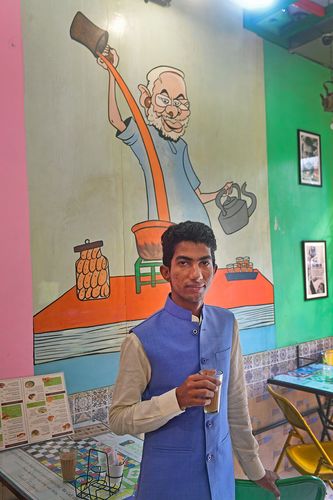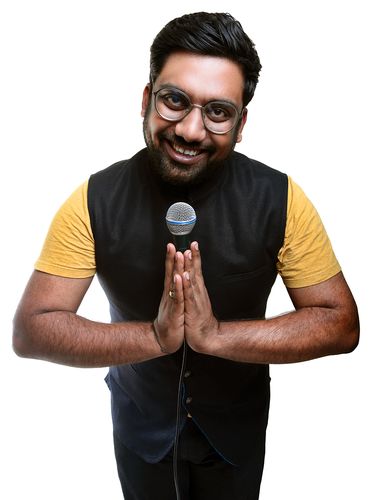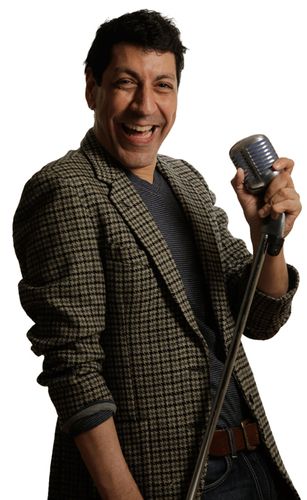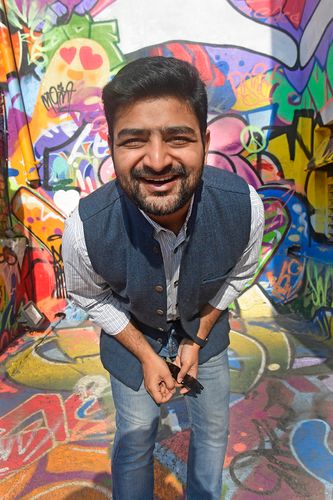Varun Grover has been following the ongoing controversy over the film Padmavati with much interest. A development like this, one would have thought, would provide great material for a comedian. But the comedian-scriptwriter feels there’s hardly anything that can be added to a script to improve the comedy on display. “Every statement out there is a joke, you don’t need to add a punch line,” Grover said. “Look at that man offering a five-crore bounty for beheading the heroine when it is clear he hasn’t got even Rs 5,000 to spare.”
“It is all very funny now, with a bunch of stupid people protesting, but the day one of them actually slits a throat, it will not be a joke anymore,” said the comedian, noting how volatile the present times are, when matters can spiral into the ugly within minutes. “These are bad times for any form of expression, no artist can feel safe in this atmosphere. But then, the worst times for comedy are actually the best times.”
Times are indeed good for comedy, with this art form emerging from its role as the sidekick to a standalone. From a handful of professional Indian comedians a decade ago, there are over 100 now, and the number is growing, said Sumendra Singh, director, Comedy Wagon Productions, a company that works with live comedy performances.
As the space of comedy expands from the open mics and bar performances to stage shows, comedy clubs and comedy festivals, the art of comedy itself is getting refined from the slapstick to the nuanced. Beyond eliciting laughter, comedy is getting incisive, expressing political dissent, touching upon uncomfortable social and personal subjects. Humour is no longer an assortment of the bawdy and the buffoonery; it encompasses a range of forms, from British-style dry humour to post-modern noire. Comedy is also becoming a primary source of news and analysis for a section of the youth, the way The Daily Show, a news comedy, was in the UK for students.
Humour is not a new art form. It has been an integral part of formula films and television shows. Hasya kavi sammelans (sessions on humorous poetry) are an established tradition, specially around Holi and Diwali. Parsi theatre in Mumbai had a repertoire of the risque and the ribald. Artists like Jaspal Bhatti commandeered a special space on television and stage. But, it is the new form of comedy, standup, and its cousins, improv and sketches, that are coming of age in India. This trend has moved comedy into the main act of a performance. Comedians are laughing their way to the bank, literally.
Take the case of Shyam Rangeela, the 22-year-old from rural Rajasthan. A YouTube video of political lampooning, four years ago, made him an overnight star—he now commands Rs 1 lakh for a live show. Rangeela’s forte is mimicry, and Prime Minister Narendra Modi is a favourite subject. His “Sonam Gupta bewafaa” video on the PM last year went viral, and even elicited a response from Modi on his Mann ki Baat radio show. Rahul Gandhi is another favourite subject. “With Rahulji, one doesn’t need punch lines—he provides them. Like that time when he said, ‘Jawaab ka sawal chahiye (need a question to this answer)’,” says Rangeela.
 Shyam Rangeela- “With Rahul gandhi, one doesn’t need punch lines—he provides them.” | Amey Mansabdar
Shyam Rangeela- “With Rahul gandhi, one doesn’t need punch lines—he provides them.” | Amey Mansabdar
Constantly following politicians in the news, Rangeela is focusing on Yogi Adityanath, the rising star, now that Arvind Kejriwal has gone all quiet. In his spare time, he stands before the mirror, saying, “Dekhiya, main ye samajhta hoon... (This is what I think)” a la Yogi. “It takes at least a year and a half before I am able to perfect mimicking a person. My Yogi act is not ready for the stage yet.”
Rangeela says he is apolitical and that he has often had leaders from across parties congratulating him on his performances. But, the comedian ran into a spot of trouble when a television channel decided not to air a programme in which he mocked Modi. “I don’t know what happened, they never gave me an explanation,” he says, shrugging off the matter. He makes television appearances, but only on news channels, not entertainment ones.
Sorabh Pant, considered one of India’s best comedians, points out that the main political class does not care too much about these jokes. “The backlash is always from some absurd, random follower who gets upset,” said Pant. “And, since the present government took a lot of time to come into power, its followers don’t want to listen to anything else.” Pant, who has just released his book, Pawan the flying accountant, doesn’t recall this anger when he cracked jokes on Manmohan Singh when he was prime minister.
Gurgaon-based performer Raghav Mandawa recalls the time he made the innocuous statement that he can make fun of some political parties and not others. Before he knew it, he was facing a barrage of anger, mostly through internet trolls.
The anger is not specific to politics and parties, notes Pant. Adds Varoon P. Anand, standup and improv comedian, “I was planning to make an April Fool’s Day video where I would just read out the preamble. You know, by just changing the tone, I can make it a very funny video. But I was advised against it. The plan has been shelved for now.”
Invariably, it is the videos, uploaded on social networking sites, which bring in the backlash. “Within closed performances, we have said such irreverential stuff that could have had our heads lopped off, if they went viral,” said Anand. “In a club, even on a stage, we are interacting directly with the audience, and while some may object to a line, there is never this anger.” But the videos on social media are what made these men and women stars in the first place. It makes them known across social and spatial swathes and helps ensure they perform for bigger live audiences and, of course, bigger money.
Social media, and the freedom it gives to comment, has made people, especially Indians, an extremely angry lot. “Everything becomes a personal attack,” said Mandawa. “You make a joke about north Indian colonisation when they say Hindi should be compulsory, and people get angry.”
 Manan Desai- “The diaspora is even touchier. Crack even one joke on demonetisation, and they get upset.”
Manan Desai- “The diaspora is even touchier. Crack even one joke on demonetisation, and they get upset.”
Many humorists, especially those starting out, are careful of minding their Ps and Qs, but most others remain quite unfazed. “One of the pastimes in this country is to get offended,’’ said Aditi Mittal, one of the country’s top women comedians. Mittal has touched upon subjects that are rarely talked about in the open, and almost never in mixed gender circles—menstruation, missed period, undergarment shopping and the like.
“Most often, threats are rather empty,” said Pant. “One outraged fellow said, ‘If you come to my building, I’ll beat you up.’ If he is so angry, he can make the effort of coming up to me, can’t he?” reasoned Pant. Rajneesh Kapoor, another Delhi-based comedian, actually hopes that someone files an FIR against his joke so that he can defend it.
Public outrage, say most, is an occupational hazard, though Grover points out that when the powers that be support the anger with their silence, it is not the best of times for artistic expression. “Censorship, though, makes the artist more creative as he looks at ways of circumventing it,” said Kapoor. “Look at the beautiful cinema that emerges from Iran, despite all the restrictions.”
Comedians, however, have a lot more on their minds right now. The industry is going through a boom phase, and India is a major player in the international comedy market. With the largest number of English speakers in Asia, India is where American, British and Australian firms are hoping to make money. Sumendra Singh recently concluded a 10-day comedy festival in Bengaluru, the biggest he’s done, and had humorists from the Melbourne Comedy Festival in attendance. “As the foreign clubs look towards India, we benefit both ways,” he explains. “We get them to perform here, and our artists also get international exposure at their clubs.”
Politics apart, comedians are experimenting with a range of other topics for stage. Many of these are personal. Mumbai-based Kabir Chandra, for instance, jokes about his divorce. He does not make light of the painful episode, but since he is an observational and personal humorist, these topics come naturally into his comedy. “There were people who cried when I announced my divorce, others cheered, and, with some audiences, there was dead silence. It is an uncomfortable topic, and people don’t like talking about it,’’ Chandra said. Kapoor is trying to make an act about his bereavement. Losing a beloved parent isn’t the regular subject for a joke, either. But, these are different times.
Comedians are evolving, moving away from the punching down kind of jokes to punching up. “I began with jokes fat-shaming Mukesh Ambani’s son,” said Grover. “Then I felt it was so bad. I am now careful. I try to punch up, targeting systems, institutions, people above me.” No-nos for him are the “vilest of subjects” like terror attacks and rape. “The Nirbhaya case cannot be spoken about in a light manner at all, from any angle. Some subjects have to be remembered with pain and anger. It is a disservice to the victims to make light of the subject in any way.’’
Since the current style of live comedy performances are typically on the western format, both bars and laughter club performances started in English, with a smattering of the local language. But you laugh the heartiest at the jokes around you in the language you think in. “Even with fancy- schmancy audiences, the local joke is the funniest,” said improv artist Dhruv Lohumi. “Game of Thrones references may be fine, but they have to have a local connect for the best punch line.” Again, English puns and wordplay may have appreciation, but it is the desi phrase—even if it is not a punch line but just a cuss word—that elicits side-splitting laughter. “It is almost as if the tension of pretending is eased, the way people crack up,” Lohumi said.
 Rajneesh Kapoor- “Censorship makes the artist more creative as he looks at ways of circumventing it.”
Rajneesh Kapoor- “Censorship makes the artist more creative as he looks at ways of circumventing it.”
And so, comedy is going the vernacular route. Hindi was the first to ease into the standup club space, and now, several regional languages like Marathi, Tamil and Gujarati are also entering the club scene. Manan Desai is a rising star of Gujarati standup. “I perform wherever there are Gujaratis, which is everywhere in the world,” said the 30-year-old from Vadodara.
Gujarati has the traditional culture of daayro, a sit-down style of comedy, where the humorist sits with a harmonium and jokes thorough songs. “The jokes are traditional too, the old-school wife-bashing, fat-shaming types. Our standups are more in tune with international trends, we are politically correct. Our jokes try to be sanitised of homophobic, racist content,” said Desai, who started The Comedy Factory with a team of six.
Apart from political correctness, Desai also tries to keep clear of political content, because “people today get enraged with everything on the surface, without even bothering to delve into the details.” He cracked a few jokes during the time of the Patidar agitation two years ago, and got death threats. “They even called up home and threatened,” he said. Desai has learnt to keep away from political jokes even abroad. “The diaspora is even touchier. They live in Florida and get all swadesi, and want to believe everything is rosy in Gujarat. Crack even one joke on demonetisation, and they get upset. There is enough other content to keep the jokes coming,” he said.
Aditya Desai eased into Marathi standup from English and is enjoying reaching out to audiences in Mumbai, Pune and Nagpur. “We’ve had stalwarts of our style of standup, with people like P.L. Deshpande. Ours is a modern take on that,” he said. He formed the Secret Marathi Standup recently with a group of friends, and decided to put up the first act on All Fools’ Day this year. “The Marathi scene has a lot of potential. The vernacular gives us reach to the smaller towns, to a varied audience,” he said.
Not just small towns, but overseas, too. At The Junction in Dubai, for instance, there are regular regional standup nights. Manan’s co-performer, Pravin Kumar, moved from English standup to Tamil.
The joke may be in any tongue; the language of laughter, however, remains universal.
 Kabir Chandra- an observational and personal humorist, topics like his divorce come naturally into his comedy | Amey Mansabdar
Kabir Chandra- an observational and personal humorist, topics like his divorce come naturally into his comedy | Amey Mansabdar
Types of live performances
STANDUP
This is the most popular form. A standup performance is scripted in advance, with punch lines in place. It is usually a one-person performance, the performer talking directly to the audience. All that a standup show requires is a comedian. Even the microphone is optional if the acoustics are good. Sometimes, an act is jazzed up with some props.
IMPROV
Derived from the word ‘improvisation’, it is a show that involves spontaneity and a minimum of two artistes. The performers take cues from the audience, so it is a more participatory art form. For instance, the audience might throw in a cue like the Padmavati controversy or demonetisation. One of the artistes starts off on that note, and the teammates chip in, the performance evolving as it develops.
Improv requires team members to be in sync with each other, and while they may have rehearsed expected punch lines and situations in advance, the show takes on its own form as it is played out. With standup shows having moved on to theatres, improv is fast occupying the space left behind in bars.
SKETCHES
A sketch is a pre-rehearsed act, with one or more performers. It is like a little skit in itself, complete with props.







